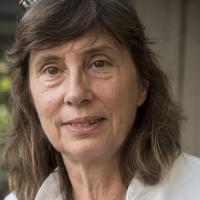
Bioeconomy Reading time 5 min
Monique Axelos, at the heart of the matter
Monique Axelos is currently the Scientific Director for Bioeconomy at INRAE. Throughout her career, she has constantly broadened her scope, from the fine structure of foods to the concept of bioeconomy, which includes all the ways biomass is used, whether related to food or not.
Published on 01 January 2019 (date.last_update 14 October 2025)
Monique has a very unique view of biological matter. For her, proteins are like marbles whose charges trigger a game of push-and-pull, silica particles are fractal aggregates (1), and pectin in jam consists of polymers in reptation that form entanglements like those of a bowl of spaghetti… In short, whatever she focuses on, her penetrating gaze cuts right to the heart of the matter, giving her an expert grasp of the mechanisms that govern interactions and the resulting properties.
From gels to foams, understanding universal structural mechanisms
It all began with Monique’s thesis in a CNRS lab on the aggregation of silica particles as a model for studying the sedimentation of sludge suspended in wastewater. Through X-ray scattering, she discovered that these particles form fractal aggregates, fascinating forms that repeat themselves over and over in an interlocking pattern regardless of scale. This caught the attention of matter theorists, who saw in Monique’s experiments the confirmation of their hypotheses.
After joining INRAE in 1986, Monique began to take an interest in pectin (2). “During the entrance exams at INRA, I didn’t hide the fact that I knew nothing about pectin, but the jury was open-minded enough to take my potential rather than my achievements into account”, says Monique. And so began the “pectin period” of the 1990s, when scientists were looking for an alternative to pork gelatin. The goal was to identify the structures at the base of the physical properties of gels. Once again, research findings led to scientific publications from theorists specialising in percolation (3).
After gels, Monique turned her attention to foams or frothy substances, like those found in dairy desserts. They owe their consistency to proteins that form walls of air bubbles, stabilising the matter by forming networks at the interface between water and air.
We were all trying to put our finger on what makes these phenomena universal
Over the course of the studies, Monique became an expert at using sophisticated measuring equipment such as LURE, then SOLEIL (4), or the Orphée nuclear reactor at CEA Saclay. She remembers nights spent adjusting beams or creating make-shift sample holders on site. “It was amazing to work with the physicists. We were all trying to put our finger on the universal traits of phenomena, regardless of the origin of the polymer or colloid (5)”.
A woman at the interface
Monique can now define herself as a woman at the interface of things: those that exist in matter, thresholds between physical and biological disciplines, and those between INRAE and the CNRS, where she still has many colleagues.
Upon invitation from Paul Colonna in 2006, who was then sole head of the scientific division CEPIA (6), Monique stepped up to join him at the helm. Monique served two four-year terms, during which she worked to create new interfaces between labs, encouraged researchers to work closely together, and helped design projects around transforming biomass.
The shift towards the bioeconomy
Be daring, always go for it, push the threshold
In 2017, Monique became INRAE’s Scientific Director for Food and Bioeconomy. Pushing boundaries ever further, she called upon agronomists, economists and sociologists to help INRA develop a road map for the bioeconomy. It’s about thinking globally about the uses of biomass, whether food-related or not, and tapping into extraordinary potential in terms of sustainable development. “For example”, says Monique, “in extracting rapeseed oil, you have to think not only about the quality of the oil, but also that of the meal protein, a by-product currently used in animal feed. Because those proteins could also be used for human food if their qualities are maintained from the get-go of the transformation process”.
The bioeconomy seeks to maximise the uses of biomass, from food to energy… a global challenge with high stakes that plays out at the local level. And a new goal for Monique, who sees her career as a series of seven-year itches, when new ideas propel her further forward. “Be daring, always go for it, push the threshold”: this could be her motto.
(1) Fractals are complex patterns that are self-similar across different scales. Examples found in nature include clouds, snowflakes and broccoli.
(2) Pectin: plant polysaccharides used mostly to make jam.
(3) Percolation is the physical process of transitioning from one state to another within a system.
(4) Soleil: particle accelerator that produces synchrotron radiation, an extremely powerful light source for exploring matter. Saclay (France).
(5) A colloid consists of suspended particles whose size ranges from nanometre to micrometre. Pectin (polysaccharide) and some proteins (ovalbumin, gelatine) form colloidal suspensions.
(6) CEPIA division: Science for Food and Bioproduct Engineering.
Mini-CV
66 years old, married, one child
Background
- SInce october 2025 : Scientific Director For Bioeconomy at INRAE
- 2017 - 2025 : Scientific Director for Food and Bioeconomy
- 2008 -2016: Head of the CEPIA division: Science for Food and Bioproduct Engineering
- 1997: Accredited to supervise research, University of Nantes
- 1986: Joined INRAE at the Physical Chemistry lab for macromolecules in Nantes
Education
- 1984: PhD in Solid State Physics and Crystallography, University of Orléans
Prizes and distinctions
- 2014 Etoiles de l’Europe Award for the European project DREAM
- 2013Trophée des Ambassadeurs Award for organising the International Conference From Model Foods to food models in Nantes (FR)
